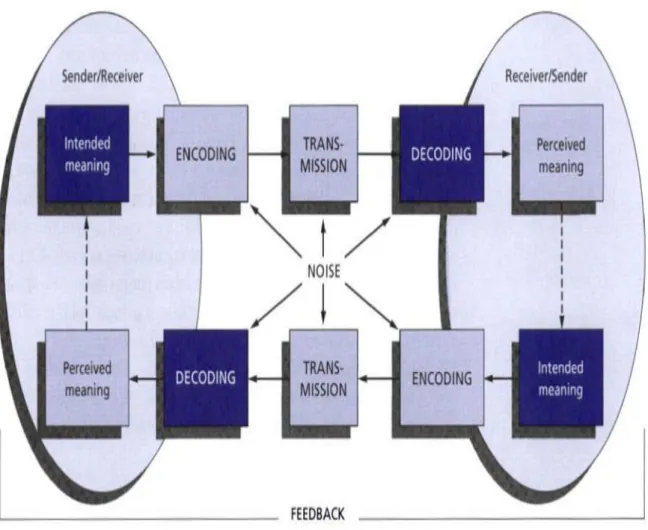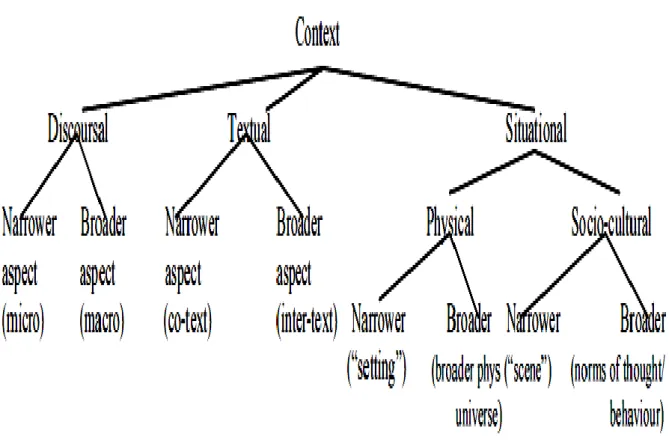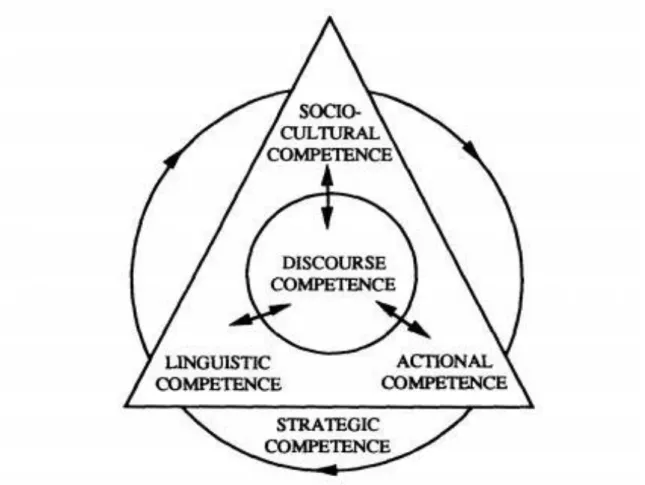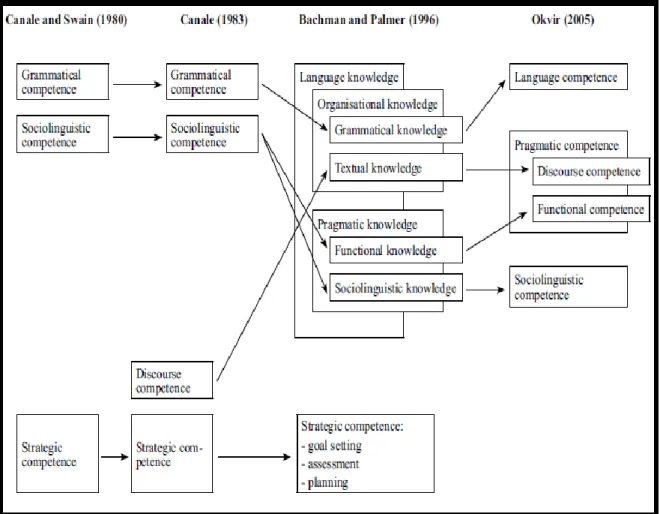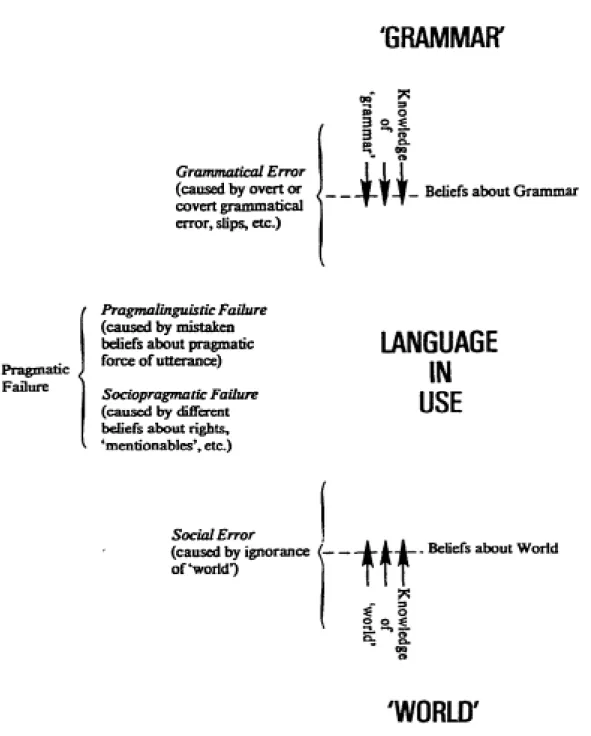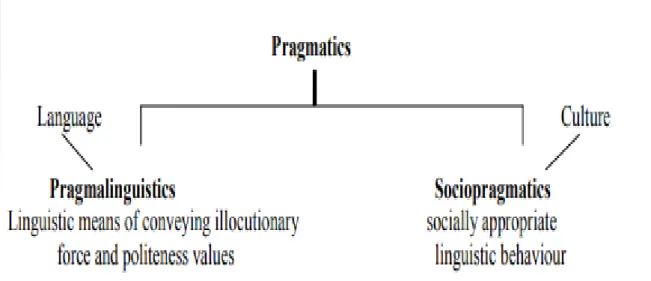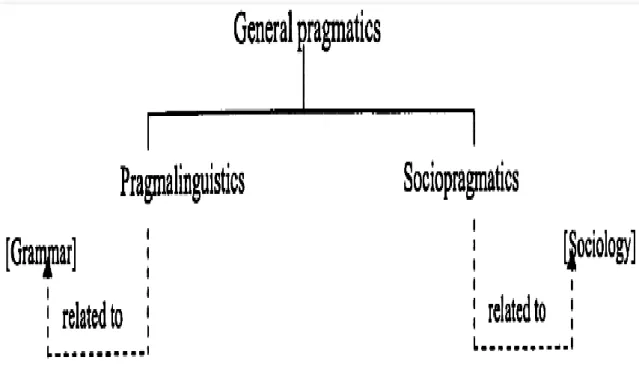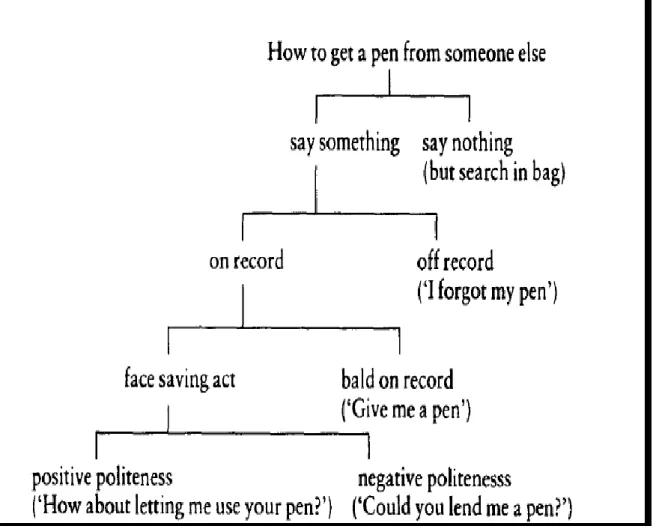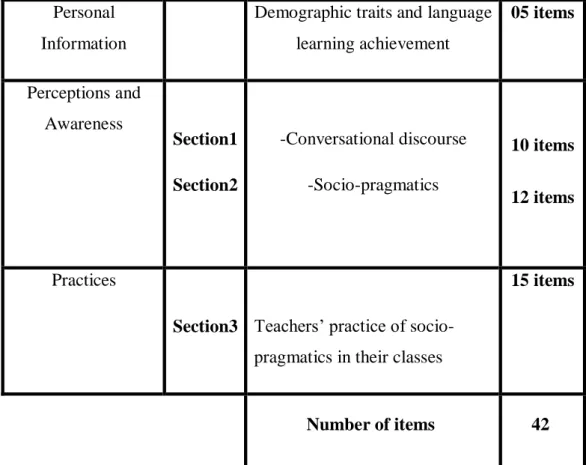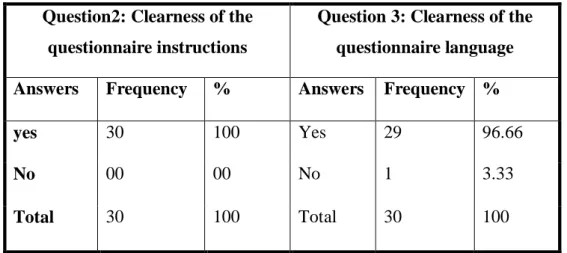People’s Democratic Republic of Algeria
Ministry of Higher Education and Scientific Research
Djillali Liabes University, SIDI BELABBES
Faculty of Letters, Languages and Arts
Department of English Language
Branch of English
Title
Thesis submitted to the Department of English in candidacy for the degree of LMD Doctorate in English Discourse Studies and Applied Linguistics
Submitted by: Mr. HAMOUDI Aboubakr Supervised by: Pr. BOUHASS BENAISSI Fawzia
Board of Examiners
Chairman: Prof. MELOUK Mohamed Djilali Liabes University, Sidi Bel Abbes
Supervisor: Prof. BOUHASS BENAISSI Fawzia Djilali Liabes University, Sidi Bel Abbes External examiner: Prof. HAMZAOUI Hafida Aboubakr Belkaid University, Tlemcen External examiner: Dr. ELOUCHDI Ilhem Aboubakr Belkaid University, Tlemcen Internal examiner: Dr. MENEZLA Nadia Djilali Liabes University, Sidi Bel Abbes
The role of Classroom Socio-pragmatic Instruction in Overcoming
Students’ Miscommunication Problems
Statement of Originality
I hereby declare that this submission is my own work, and that it contains no material previously published or written by another person nor material which has been accepted for the qualification of any other degree or diploma of a university or other institution. I also certify that the present work contains no plagiarism and is the result of my own investigation, except where otherwise stated.
Mr. HAMOUDI Aboubakr Date: 01/01/2019
Dedication
To my parents, whose courage and devotion have inspired me all my life To my future wife and children,
To my brothers, my sisters,
and their respective families. To all my friends
Acknowledgments
I would like to seize this opportunity and thank all of the people who have supported me during my PhD journey. First and above all, I would like to thank Allah the first
source of inspiration and blessings to me.
I owe a special debt to my supervisor Pr. BENAISSI Fawzia for her time, endowment, and fruitful orientation during my thesis writing process. I also would like to heartily express my deepest appreciation and gratitude to my great parents for instilling in me the spirit of
persistence that has enabled me to pursue and achieve my goals
Special thanks go to the board of examiners without whom my thesis would not have been corrected, refined and defended. By names, I thank Prof. MELOUK Mohamed, Prof.
HAMZAOUI Hafida, Dr. ELOUCHDI Ilhem and Dr. MENEZLA Nadia
I vow exceptional gratitude to my adorable and dear teachers Dr. Touati , Dr. Bouazid and Ms Cheriet they were always right by my side and they always had faith in my potentials. I thank them for many reasons and especially for their extraordinary sympathy,
Abstract
Social (in)appropriacy in language use is a multidimensional construct of variation across cultures, languages, and speech situations. As learning/teaching any second/foreign language entails successful communication as an ultimate objective, internalizing the L2 socio-logical features and conditions that normalize speech in context has become an urge in SL/FL education. That is, L2 socio-pragmatics knowledge and instruction, be it awareness raising or content teaching-oriented, constitute a fundamental axis to bolstering L2 learners’ conversational discourse in real life exchanges of interaction. This study sets forth an exploratory discussion to EFL teachers’ instruction in and consciousness, as well as students’ awareness, of the construct of socio-pragmatics within the department of English at M’sila university. It also runs an initiative to integrating socio-pragmatics awareness-raising intervention in EFL classes as an attempt towards aiding students improve their conversational discourse performance. To carry out the study, a quasi-experimental design is adhered to. An observational method, questionnaires, and T-tests, in a form of Discourse Completion Tasks (DCTs), are used to measure teachers and students’ awareness of socio-pragmatics, and to explore tutors’ instruction in the construct. The DCTs are used to measure students’ conversational discourse performance, at both levels of production and interpretation, before and after the intervention. Participants in the study include 60 EFL teachers and 100 third year EFL students at M’sila university. The findings demonstrated students’ noticeable lack of awareness about socio-pragmatics. Moreover, although teachers held sufficient consciousness levels of socio-pragmatics, most of them showed scarce socio-pragmatics instruction in their classes. In parallel, students demonstrated statistically significant differences in their conversational discourse performance before and after the implementation of the socio-pragmatics awareness-raising intervention along the instructional time. It is then advocated that instruction in L2 socio-pragmatics be laid a particular attention and be integrated in EFL learning settings.
List of Abbreviations and Acronyms CA: Conversation Analysis
CLT: Communicative Language Teaching DA: Discourse Analysis
DCT: Discourse Completion Task/Test EFL: English as a Foreign Language
ESL: English as a Second Language ICC: Intra-class Correlation Coefficient ILP: Interlanguage Pragmatics
INEPN: Insights Needs Exploration Practice Natural use reasoning development. L1: First Language L2: Second Language M: Mean (Average) N: Number NNS(s): Nonnative Speaker(s) NS(s): Native Speaker(s)
r: Pearson’s Correlation Coefficient
SARI: Sociopragmatics Awareness Raising Intervention SD: Standard Deviation Sig: Significance
SLA: Second Language Acquisition
SPAQ: Students’ Perceptions and Awareness Questionnaire TL: Target Language
List of Tables
Table 3.1: Structure of the Observation Grid……….. 104
Table 3.2: Structure of the TPAQ………... 108
Table 3.3: Piloting the TPAQ Completion Time………... 109
Table 3.4: Piloting the TPWQ Clearness of Instructions and Language……… 110
Table 3.5: Piloting the TPWQ Ambiguity of Items……… 111
Table 3.6: Structure of the SPAQ………... 114
Table 3.7: Piloting the SPAQ Completion Time……….... 115
Table 3.8: Piloting the SPAQ Clearness of Instructions and Language………... 116
Table 3.9: Piloting the SPAQ Ambiguity of Items………... 117
Table 3.10: Structure of the DCT……… 121
Table 3.11: Overall Native Speakers’ Rank Means of the Answers (a, b, c, d) in Terms of Appropriateness of Speech Act Realization……… 123 Table 3.12: Socio-Pragmatics Awareness Raising Contents Template……….. 129
Table 3.13: Experiment Phases………... 131
Table 3.14: Sample lesson of a Socio-pragmatic Awareness Raising Training (theory)… 132 Table 3.15: Sample Lesson of a Socio-pragmatic Awareness Raising Training (Practice) 133 Table 4.1: Cronbach’s Alpha Values for Total Awareness Score Items………. 142
Table 4.2: Pearson Correlation Coefficient Values between Sections Scores and the Whole Awareness Test Scores………. 143
Table 4.3: Pearson Correlation Between Section 1 Total Score and Items’ Scores……… 143
Table 4.4: Cronbach’s Alpha Values for Total Experience/Practice Score Items……….. 145
Table 4.5: Pearson Correlation Coefficient Values between Sections Scores and the Whole Experience/Practice Test Scores………... 145
Table 4.6: Pearson Correlation Between Sections 2 and 3 Total Score and Items’ Scores 146 Table 4.7: Cronbach’s Alpha Values for Total Awareness Score Items………. 147
Table 4.8: Pearson Correlation Coefficient Values Between Sections Scores and the Whole Awareness Test Scores………. 148
Table 4.9: Pearson Correlation Between Section 1 Total Score and Items’ Scores……… 148
Table 4.10: Pearson Correlation Between Section 2 Total Score and Items’ Scores…….. 149
Table 4.11: Cronbach’s Alpha Values for Total Practice/ Experience Score Items……... 149
Table 4.13: Cronbach’s Alpha Values for Total DCTs and its Sections……… 151
Table 4.14: Intra-class Correlation Coefficient of DCTs Test Raters……… 152
Table 4.15: Reliability Analysis of the Raters’ Scoring of the DCTs Test Sections……. 152
Table 4.16: Inter-rater Reliability Analysis……… 153
Table 4.17: Pearson Correlation Coefficient Values Between Sections Scores and the Whole Test Scores………... 154
Table 4.18: Pearson Correlation Between Linguistic Performance Section Total Score and Items Scores……….. 154
Table 4.19: Pearson Correlation Between Discourse Production Section Total Score and Items Scores………. 155
Table 4.20: Pearson Correlation Between Discourse Interpretation Section Total Score and Items Scores……….. 155
Table 4.21: Students’ Perceptions of Their University Courses’ Main Focus……… 156
Table 4.22: Students’ Main Purpose of Choosing English at University……….. 157
Table 4.23: Students’ Perceptions of Their Level in English………. 157
Table 4.24: Students’ Perceptions of Their Levels of Fluency………... 158
Table 4.25: Students’ Skills Rank Means………... 158
Table 4.26: Students’ Awareness Level Intervals Using the Mean Technique………….. 159
Table 4.27: Students Awareness About Conversational Discourse……… 159
Table 4.28: Extent of Experience/Practice Level Intervals Using the Mean Technique… 161 Table 4.29: Students Extent of Experience/Practice About Conversational Discourse…. 161 Table 4.30: Students Awareness of Socio-pragmatics……… 163
Table 4.31: Students Experience of Teachers’ Practice and Instruction in Socio-pragmatics……… 165
Table 4.32: Teachers’ Gender………. 167
Table 4.33: Teachers’ Qualifications……….. 167
Table 4.34: Teachers Length of Teaching Experience in Years………. 167
Table 4.35: Teachers’ Majors……….……… 168
Table 4.36: Teachers’ Evaluation of Their Classes………. 168
Table 4.37: Teachers’ Awareness Level Intervals Using the Mean Technique………….. 170
Table 4.38: Teachers Awareness About Conversational Discourse………... 170
Table 4.39: Teachers Awareness Levels About Socio-pragmatics………. 172
Table 4.41: Teachers Practice of Classroom Socio-pragmatics………. 175
Table 4.42: Oral Expression Teachers’ Observation Data for 8 Sessions……….. 177
Table 4.43: Teachers of Pragmatics, Civilization, TEFL and Sociolinguistics’ Observation Data for 8 Sessions……….. 179
Table 4.44: Conversational Discourse Pre-test Total Scores Descriptive………... 181
Table 4.45: Pretest Linguistic Performance Scores Descriptives………... 181
Table 4.46:Pre-test Discourse Production Scores Descriptives……….. 182
Table 4.47: Pre-test Discourse Interpretation Scores Descriptives……… 183
Table 4.48: Paired Sample Test Between Pre Test and Progress Test1 Scores………….. 184
Table 4.49: Pre Test and Progress Test1 Three Sections Difference test………... 185
Table 4.50: Pre test and Progress test 2 Mean and Std. D Values……….. 186
Table 4.51: Pre test and Progress test 2 Mean and Std. D Values of the Three Sections... 187
Table 4.52: Progress test1 and Progress test 2 Mean and Std. D Values……… 188
Table 4.53: Paired Sample T test Between Progress Test 1 and 2 Sections Scores……… 189
Table 4.54: Conversational Discourse Post-test Total Scores Descriptives………... 191
Table 4.55: Post-test Linguistic Performance Scores Descriptives……… 191
Table 4.56: Post-test Discourse Production Scores Descriptives……… 192
Table 4.57: Post-test Discourse Interpretation Scores Descriptives………... 193
Table 4.58: Paired sample T test between Pre and Post Test Scores………. 195
Table 4.59: Paired sample T test between First Section Pre and Post Tests’ Sections Scores………... 196
Table 5.1: Practice of Instruction Level Intervals Using the Mean Technique………….. 215
Table 5.2: Teachers and Students’ Mean Values about Instruction in Socio-pragmatics... 215
Table 5.3 Teachers’ Observation Data for 16 Sessions………... 218
Table 5.4 : Conversational Discourse Pre-test sections’ Total Scores Descriptive……… 224
Table 5.5: Cumulative paired Differences between Progress Assessment Tests and Pre-test Results in Terms of Sections………. 227
Table 5.6: Cumulative Total and Sectional Paired Differences between Conversational Discourse Pre and Post-test Scores……….. 228
List of Figures
Figure 1.1: Communication’s Model……….. 11
Figure 1.2: Cornish Schematic Representation of Context………. 15
Figure 1.3: Components of Communicative Competence ………. 17
Figure 1.4: Similarities and Differences Between Models of Communicative Competence……….. 18
Figure 1.5: The Possible Causes of Miscommunication ……… 39
Figure 1.6: Pragmatic Transfer Continuum: Language-Culture ……… 47
Figure 2.1: The NAPKIN Model for Teaching Pragmatics………... 71
Figure 2.2: Leech’s Model of Pragma-linguistics and Socio-Pragmatics ………. 76
Figure 2.3 :Politeness in Term of Formality………... 86
Figure 2.4: Brown and Levinson’s Politeness Strategies……… 87
Figure2.5: Ahmed’s Visualization of the Domains of Authenticity………... 94
List of Graphs
Graph 4.1: Conversational Discourse Pretest Total Scores Descriptives………... 181
Graph 4.2: Linguistic Performance Pre-test Scores Histogram……….. 182
Graph 4.3: Discourse Production Pre-test Scores Histogram………. 183
Graph 4.4: Discourse Interpretation Pre-test Scores Histogram……… 184
Graph 4.5: Pre test Progress test 1 Differences……….. 185
Graph 4.6: Pre-Test and Progress Test 1 Differences in the Three Sections……….. 186
Graph 4.7: Pre-test Progress Test 2 Differences……… 187
Graph 4.8: Pre test and Progress test 2 Differences in the Three Sections………. 188
Graph 4.9: Progress test 1 and 2 Differences………. 189
Graph 4.10: Progress test 1 and 2 Differences in the Three Sections……… 190
Graph 4.11: Conversational Discourse Post-test Total Scores Histogram………. 191
Graph 4.12: Linguistic Performance Post-test Scores Histogram……….. 192
Graph 4.13: Discourse Production Post-test Scores Histogram………. 193
Graph 4.14: Discourse Interpretation Post-test Scores Histogram………. 194
Graph 4.15: Pre and Post Test Total Scores’ Mean Differences……… 195
Graph 4.16:Cummulative Pre and Post Tests Sections Scores……… 196 Table of Contents
Statement of Originality………... II
Dedication……… III
Acknowledgements ………... IV
Abstract ………... V
List of Abbreviations and Acronyms………... VI List of Tables ………..….... VII
List of Figures ………..………….…….. X
List of Graphs……….………..……... XI
General Introduction
Background of the Study………..…… 1
Statement of the Problem ………..….…. 3
Aim of the Study ………...……….. 4
Research Questions ………...………..………. 5
Hypotheses ………...………….……… 5
Research Tools ……….……... 6
Structure of the Study ………..………..……. 7
Chapter One Language Use, Discourse and Conversation Introduction………... 8
1.1 Definition of Communication ………. 9
1.1.1 The Process of Communication………. 10
1.1.2 Verbal and non-Verbal Communication ……… 11
1.1.3 Use and Usage of Language ……….. 12
1.2 Communication and Context ……….. 14
1.3 Communicative Competence………... 16
1.4 The Ethnography of Speaking………. 18
1.4.1 Hymes SPEAKING Grid……… 19
1.4.2 Communication Across Cultures……… 21
1.5 The pragmatics of Communication……….……….... 22
1.6 Conversational Discourse……….... 23
1.6.1 Definition of Conversation ………... 23
1.6.2 Discourse and Conversation……….. 24
1.6.3 Conversation Process………. 25
1.6.3.1 Features of Conversation………... 26
1.7 Discourse Structure in Conversation……….………. 27
1.7.1 Conversational Style……….. 28
1.8 Language Use and Socialization ………... 30
1.8.1 Framing and Contextualization Cues ………. 31
1.8.2 Conversational Inference………. 32
1.8.3 Norms of Interaction……… 32
1.8.4 Conversational Routines ……….. 32
1.9 Social Correlates with Conversational Discourse ……… 33
1.9.1 Social Class………... 33
1.9.2 Gender and Age………... 34
1.9.3 Ethnic Varieties and Speech Communities………... 34
1.10 Conversation Analysis and Discourse Analysis……….. 35
1.11 Communication Barriers……….. 37
1.11.1 Misunderstandings ………... 40
1.11.2 Types of Misunderstandings………. 41
1.11.3 Examples of Misunderstandings………... 42
1.11.4 Pragmatic Failures……….... 43
1.11.5 Types of Pragmatic Failure……….. 44
1.11.6 Pragmatic Transfer……… 45
1.12 Teaching Language as Communication ……….. 47
1.13 Classroom Discourse and Natural Discourse……….. 49
Conclusion……… 51
Chapter Two Socio-Pragmatics as a Social Construct to Verbal Behaviour Introduction……….. 52
2.1 Background on Sociolinguistics……….. 53
2.2 Sociolinguistics and the Sociology of Language……… 54
2.3 Areas of Sociolinguistics……… 56
2.3.1 Linguistic Variation ………... 56
2.3.2 Language Planning……….. 57
2.4 Interactional Sociolinguistics……….. 58
2.6 Sociolinguistics in Language Teaching……….. 61
2.7 Pragmatics………... 62
2.7.1 Origin and Definition. ……… 62
2.7.2 Macro-pragmatics and Micro-pragmatics………... 64
2.8 Interlanguage Pragmatics……… 66
2.9 Intercultural Pragmatics and Cross-cultural Pragmatics………. 67
2.10 Pragmatic Competence………... 68
2.11 Teaching L2 Pragmatics………. 69
2.11.1 The NAPKIN Model……… 70
2.11.2 The SURE Steps………... 72
2.12 The Interplay Between Sociolinguistics and Pragmatics………... 73
2.13 Socio-Pragmatics: Definition and Focus ……… 74
2.14 Pragma-linguistics and Socio-pragmatics………... 76
2.15 Areas of Socio-pragmatics……….. 77
2.15.1 Speech acts………... 77
2.15.1.1 Components of a Speech Act……… 78
2.15.1.2 Felicity Conditions……… 79
2.15.1.3 Speech Act taxonomy………... 79
2.15.2 Conversational Implicatures………. 80
2.15.2.1 The Cooperative Principle ………... 81
2.15.3 Sociolinguistic aspect of language use……… 83
2.15.4 Politeness………. 85
2.16 The Role of Socio-pragmatics ……….. 88
2.17 Teaching Socio-pragmatics in EFL Context ……….. 89
2.17.1 Awareness Raising Instruction………. 91
2.17.2 Material Authenticity………... 93
2.17.3 Conversation Analysis Resources……… 95
2.18 Strategies for Developing Socio-pragmatic Competence in ESL………... 97
Chapter Three
Research Methodology, Tools and Procedures
Introduction……… 100
3.1 Methodology and Procedures………. 101
3.1.1 Research Design ………. 101
3.1.2 Research Setting and Participants………... 102
3.2 Research Tools………... 103
3.2.1 Classroom Observation Grid (COG)………. 103
3.2.2 Tearchers’ Perceptions and Awareness Questionnaire ( TPAQ)……… 105
3.2.2.1 Development of the TPAQ ………... 105
3.2.2.2 Types of Questions ……….. 106
3.2.2.3 Structure of the TPAQ ……….………... 107
3.2.2.4 Pilot Study of the TPAQ ………. 109
3.2.3 Students’ Perceptions and Awareness Questionnaire (SPAQ)………... 111
3.2.3.1 Development of the SPAQ ……….. 112
3.2.3.2 Types of Questions ……….. 112
3.2.3.3 Structure of the SPAQ ………. 113
3.2.3.4 Pilot Study of the SPAQ ………. 115
3.2.4 Discourse Completion Tasks (DCT)………... 117
3.2.4.1 Development of the DCTs………... 117
3.2.4.2 Structure of the DCTs ………………. 120
3.2.4.3 Scoring Procedures of the DCTs……….. 122
3.2.4.4 Pilot Study of the DCTs………... 125
3.2.5 Socio-pragmatics Awareness-Raising Intervention (SARI)………... 125
3.2.5.1 Development of the SARI ……….. 125
3.2.5.2 Length of the SARI ………. 127
3.2.5.3 Type of Instruction and Activities of the SARI ………. 128
3.2.5.4 Instructional Materials………. 130
3.2.5.5 Sample lesson of the SARI ………. 131
3.2.5.6 Pilot Study of the SARI ……….. 134
3.2.7 Statistical Tools ……….. 136
3.4 Study Procedures ……….….. 139
Conclusion ……….. 140
Chapter Four Results and Data Analysis Introduction……….. 141
4.1 Pilot Study of the Research Tools……….. 142
4.1.1 The SPAQ Piloting Data……….. 142
4.1.1.1 Students Awareness Scale Reliability and Validity……….……… 142
4.1.1.2 Students Experience/Practice Scale Reliability and Validity……….. 144
4.1.2 The TPAQ Piloting Data………. 147
4.1.2.1 Teachers Awareness Scale Reliability and Validity……… 147
4.1.2.2 Teachers Experience/Practice Scale Reliability and Validity………. 149
4.1.3 Students’ DCTs Piloting Data……….. 150
4.1.3.1 DCTs Validity and Reliability………. 151
4.2 Results and Data Analysis……… 156
4.2.1 The SPAQ Data Analysis……… 156
4.2.2 The TPAQ Data Analysis……… 167
4.2.3 The Observation Grid Data Analysis………... 177
4.2.4 The Experiment Data Analysis……… 180
4.2.4.1 Pre-test Data Analysis……… 180
4.2.4.2 Progress Assessment Tests Data Analysis………. 184
4.2.4.3 Post Test Data Analysis………. 190
4.2.4.3.1 Pre and Post Treatment Difference Tests………. 194
Chapter Five
Discussions and Implications
Introduction……….. 198 5.1 Restatement of the Research Questions and Hypotheses………... 199 5.2 Summary of the Findings……….. 200 5.3 Students’ Study Experience, English Courses, Purposes, Levels and Skills in English
and Their Correlation with Their Awareness of Socio-pragmatics………... 204 5.4 Students English Courses, Purposes, Levels and Skills in English and Their
Correlation with Their Conversational Discourse Pre-test Results………... 206 5.5 Students’ Conversational Discourse Perceptions and Awareness in Correlation with
Their Conversational Discourse Practice ……….. 207 5.6 Students’ Awareness about Conversational Discourse and Socio-pragmatics in
Correlation with Their Conversational Discourse Pre-test Results……… 209 5.7 Teachers Qualifications, Majors and Experience in Correlation with Their
Awareness of Conversational Discourse and Socio-pragmatics………... 210 5.8 Teachers’ Awareness of Socio-pragmatics in Correlation with Students’ Awareness
of Socio-pragmatics………... 212
5.9 Teachers’ Instruction in Socio-pragmatics in Correlation with Students’ Perceptions of Teachers’ Classroom Practice about Socio-pragmatics……… 214 5.10 Teachers’ Awareness of Conversational Discourse in Correlation with Their Levels
of Instruction in Socio-pragmatics……… 220
5.11 Teachers’ Socio-pragmatics Awareness in Correlation with Their Instruction in
Socio-pragmatics……… 221
5.12 Teachers’ Awareness of Socio-pragmatics and Conversational Discourse in Correlation with Students’ Conversational Discourse Pre-test Performance ………... 223 5.13 Teachers’ Instruction in Socio-pragmatics in Correlation with Students’
Conversational Discourse Pre-test Performance……… 225 5.14 Conduction of the socio-pragmatics Awareness-raising Intervention in
Correlation with Students’ conversational discourse pre, progress and Post-tests
5.15 Improving Students’ Conversational Discourse through Raising Their Awareness of Socio-pragmatics………... 229 5.16 Pedagogical Implications………. 231 Conclusion………... 241 General Conclusion ……….……….. 242 References ……….. 247 Appendices………..
General Introduction 1. Background of the Study
Language, by and large, symbolizes the apparatus which systematically nourishes human communication. A world without language portrays a dreadful space wherein furious behaviours would perhaps fill in for subtle words. Language use is a universal phenomenon. However, it is unsurprisingly an ethnic socio-cultural and interactional activity. language use underlies a set of parameters that regulate the conception of messages and promote the establishment of social rapports. These parameters are specific to language itself, background culture, and the setting of actual communication. In this respect, language use across-cultures forges discrepant norms of interaction, rhetorical routines, and perceptual views of the world into the scene of communication. Cross-cultural language use is a complex process accordingly.
Studying conversational discourse, as a form of language use (e.g Jones, 1981; Blundell, Higgens and Middlemiss, 1982; Nolasco and Arthur, 1987; Bygate, 1987; Cook, 1989; McCarthy, 1991; and McCarthy and Carter, 1994), entails a set of underlying principles featuring peoples’ every day conversations. That is, language users exploit language distinctively depending on a number of variables, social situations and participants for instance, around them. In brief, when the environmental setting of language use changes the language itself does too. This makes language use, or conversational discourse in specific, an interactional socio-linguistic behaviour that is situated in particular circumstances in social life. This latter gives account to the stipulation that each social group has its own ways of communicating meanings and intents using its own code. In this vein, numerous aspects and features of language use gained much attention and led researchers into much controversy.
Linguistic and non-linguistic features pertaining to socio-linguistic aspects, address forms for example, of language use, speech acts, conversational implicatures, discourse markers, conversational routines in a given language, politeness strategies, conversational inferences, conversational styles, para-linguistic manifestations, socio-cultural norms of interaction, misunderstandings and pragmatic failures, contextualization clues, and adjacency pairs led to the outbreak of several disciplines and sub-disciplines such as socio-linguistics, pragmatics, conversation and discourse analysis, cross-cultural pragmatics,
interlanguage pragmatics, pragma-linguistics, pragmatics, interactional socio-linguistics, cross-cultural and intercultural communication, as well as cultural linguistics. Interests and findings in these areas of research enlarged the scope of applied linguistics and promoted language education in general.
In second and foreign language education, the use of pragmatics, socio-linguistics, conversation/discourse analysis and cross-cultural communication, including their sub-disciplines, to language teaching, learning and use has been of sound contributions. While pragmatics studies meanings in language use as delivered by speakers and interpreted by listeners (Szabo-Gendler, 2005), sociolinguistics lends itself to: the study of the relationship between language and society, as a specialisation (Van Herk,2012). Furthermore, whereas conversation analysis attempts to extract the organizational patterns of language use regarding the speakers’ perspective (Hutchby and Wooffitt, 2008), and discourse analysis studies language beyond the sentence as well as the interactive features of everyday communication and language in situational and cultural context (Trappes-Lomax, 2006), cross-cultural communication is a social phenomenon that concerns a number of disciplines such as anthropology, sociology, psychology and linguistics (Zhou, 2008).
Socio-pragmatics is a subfield of pragmatics and a recombination between socio-linguistics with pragmatics. It is “the sociological interface of pragmatics” and it pertains to “the social perceptions underlying participants' performance and interpretation of linguistic action” (Leech, 1983, p. 10). Moreover, the construct carries the meaning of understanding the external social and contextual variables under which particular language use strategies, formulas and perceptions are socially appropriate (Thomas, 1983 and Crystal, 2008). Therefore, a distinction is made between pragma-linguistics and socio-pragmatics in a way that the former can be applied to the study of the linguistic ends of pragmatics and it provides essentially linguistic resources (frames) for the correct transference of certain illocutions, however the latter is applied to identifying knowledge of the socio-cultural norms as well as conditions of language use and its role is to naturalize speech production and perception (Alcon and Martinez-Flor ,2008).
The use of socio-pragmatics has its documentation rooted in a body of literature (e.g. Dascale, 1985; Harlow, 1990 and Demirezen, 1991). In particular, research into L2 teaching, learning and use held much promise to the importance of instruction in
socio-pragmatics (e.g. Safont-Jorda, 2005; Roohani-Mirzaei and Esmaeili, 2012; Cohen, 2008; Xiaole, 2009; Zhang and Yan 2012; Zangoei and Derakhshan 2014). In this respect, many researchers have claimed for the necessity to integrate socio-pragmatics in the L2 teaching context using a number of approaches and techniques (e.g. Schmidt,1993; Rose, 1999; Eslami-Rasekh, 2005; Chin-Linn, 2007; Usó-Juan and Martínez-Flor, 2008; Echeverria, 2009; Alcón Soler and Guzmán Pitarch, 2010; Ishihara, 2010; Abolfathiasl and Abdullah, 2015; Ekwelibe, 2015) to aid L2 learners acquire the l2 socio-pragmatic features of language use and minimize aspects of miscommunication accordingly.
2. Statement of the Problem
Although language is a system of systems and a composite of a highly organized patterning, it is sometimes wanting and language use can possibly flip into a slippery act that stimulates miscommunication and holds back comprehensiveness amongst language users. In light of this, Tannen (1992.p. 60) states that:
The beauty and pitfalls of language are two sides of the same coin. A word spoken, a small gesture can have meaning far beyond its literal sense. But, subtle signals can be missed and meaning can be gleaned that wasn’t intended and that may or may not be valid. Our power to communicate so much by so few words inevitably entails the danger of miscommunication
For L2 learning contexts, as is the case in the present study, learning English as a foreign language in a non English speaking community forges learners into perplexing challenges such as that of acquiring the L2 pragmatic competence. Perhaps because learners lack the opportunity to invest their knowledge of the language and naturally interact, outside the formal context, with natives or other speakers of English. Or, maybe because of the type of instruction they receive most of the time that is grammar-specific. Certainly, however, “a learner of high grammatical proficiency will not necessarily show concomitant pragmatic competence” (Bardovi-Harlig, 1996, p. 21).
As their learning is decontextualized and detached from the outside world of language, learners’ performance in real life language use situations is prone to communication dangers such us misunderstandings and pragmatic failure. EFL teachers are the agents of change because “Left to their own devices with respect to contact with the
acquire the pragmatics of the language on their own” (Bardovi-Harlig and Mahan-Taylor, 2003, p. 6).
Meanwhile, language teaching has ushered in a see change and teachers have attempted to blend in between the language their students receive in the classroom and the situations they confront in the outside context of use. However,
there has never been a greater tension between what is taught in the classroom and what the students will need in the real world once they have left the classroom. In the last decades, that world has changed to such an extent that language teachers are no longer sure of what they are supposed to teach nor what real world situations they are supposed to prepare their students for (Kramsch, 2014, p. 296)
Accordingly, many EFL students are surprised because, despite the fact that they have a fairly good command of the English grammar and pronunciation, they find a difficulty to understand messages and immediately sound appropriate while communicating in natural contexts of English language use. In particular reference to this study’s rationale, EFL students at M’sila university, Algeria proved poorly insufficient levels of socio-pragmatic appropriacy in realizing a set of speech acts, because they differed with British native speakers in the choices of speech act strategies, the perceptions of the socio-pragmatic contents, and the degree of (in) directness. This may put students’ language use at the disposal of communication failures (Hamoudi and Bouhass-Benaissi, 2018).
3. Aim of the Study
Research into conversational discourse in cross-cultural communication and interlanguage pragmatics has been carried out for almost three decades. However, the present study was decided on in light of the basic assumption that the Algerian context has not witnessed extensive research in these areas. As it stands, studies pertaining to interlanguage pragmatics and cross-cultural communication can be said to be still, in Algeria, in their infancy. Investigations in these areas, with particular reference to Algeria, proved high adherence to studying language in itself and for itself i.e., tackling spheres of grammar, phonology, morphology, syntax as well as semantics in the context of EFL teaching and learning.
In this regard, the current research aims, in the first place, to relate research at the level of interlanguage pragmatics in Algeria to the wider research community. Moreover, this research intents to raise students’ awareness of the construct of socio-pragmatics as part of their English language learning and use. Furthermore, it is an attempt to bring the outside world of language into the classroom to foster students’ understanding of the underlying principles governing real life language use. Besides, this study is an initiative to aid students improve their conversational discourse in real life situations of language use. At last, the study provides implications and suggests recommendations that would assist the L2 pedagogy of socio-pragmatics as well as of natural language use.
4. Research Questions
The present study is an attempt to answer the following questions:
1. What are the levels of awareness EFL third year students at M’sila University hold about the underlying perceptions of conversational discourse and socio-pragmatics as parts of their language learning and use?
2. What are the levels of awareness EFL teachers at M’sila University hold about the underlying perceptions of conversational discourse and socio-pragmatics as parts of their language teaching?
3. Do EFL teachers at M’sila University integrate socio-pragmatics-based instructions in their language teaching classes?
4. How can a socio-pragmatics awareness-raising intervention play a facilitating role in improving students’ conversational discourse?
5. Research Hypotheses
This study puts forward four main research hypotheses. These are:
1. EFL third year students at M’sila University may hold low levels of awareness about the underlying perceptions of conversational discourse and socio-pragmatics as parts of their language learning and use.
2. EFL third year Teachers at M’sila University may hold high levels of awareness about the underlying perceptions of conversational discourse and socio-pragmatics as parts of their language teaching
3. EFL teachers at M’sila University may not integrate sufficient socio-pragmatics-based instructions in their language teaching classes.
4. If EFL learners receive socio-pragmatics awareness-raising instruction, they would be able to improve their conversational discourse.
6. Research Tools
To answer the research questions and verify the hypotheses postulated in the present study, two questionnaires were designed and distributed to the teachers and students participating in this investigation. These instruments were used to answer questions related to the levels of awareness EFL teachers and third year students at M’sila University hold about the underlying perceptions of conversational discourse and socio-pragmatics as parts of their language teaching, learning and use. At the same time, these questionnaires included sections probing for teachers’ instruction in socio-pragmatics. Both teachers and students answered a section in their questionnaires that tried to collect data about whether or not, and to what extent, EFL teachers integrate socio-pragmatics-based instructions in their language teaching classes. Moreover, an observation grid was implemented to further answer, and confirm data gathered about, the same question about teachers’ instructions in socio-pragmatics.
Besides, this research implemented an experiment to answer the last question pertaining to whether or not a socio-pragmatics awareness-raising intervention would play a facilitating role in improving students’ conversational discourse. In this respect, discourse completion tasks (henceforth DCTs) were used to accumulate data about the respondents’ answers in the pre and pos-tests used in the intervention. Two progress assessment tests were also used, in a form of DCTS, to check out the effectiveness of the intervention in due ongoing time. Along with the instructional perid of the pedagogical implementation, the SPEAKING grid was used as a tool of conversation analysis that the study intervention relied on to inspect the materials adopted as resources of the socio-pragmatic features under instruction.
7. Structure of the Study
The present thesis falls into five chapters:
The first chapter introduces general issues related to the process of communication, language use and socialization , as well as communicative competence. It also dwells on features of conversational discourse, the study of conversation and aspects of miscommunication in language use. Furthermore, the first chapter elaborates about classroom discourse versus natural discourse as well as about the use of conversation analysis to teaching discourse.
The second chapter rather dissects pragmatics as a recombination of socio-linguistics with pragmatics. It first introduces socio-socio-linguistics in general and its sub-fields and socio-linguistic competence in the L2 context. Then, this chapter elaborates about pragmatics and its areas as well as components and pragmatic competence in FL context. At last, chapter two gives an account to socio-pragmatics as a subfield of pragmatics. It provides an overview regarding definitions, significance and its place in second and foreign language learning and teaching.
The third chapter discusses the methodological issues of the study. These pertain to the research method, design, and the different tools used for collecting data about the participants’ views, perceptions, awareness levels and performance. This chapter also describes the research setting and participants and specifies the different procedures, statistical tools and measures used in the study.
The fourth chapter is devoted to the exposition of the obtained results through all the tools used in this study. It displays results and numerical findings in correspondence with the research questions and hypotheses put forward.
The fifth and last chapter in this study is devoted to the detailed discussion of the findings and answering the research questions as well as verifying the hypotheses. It ends with the implications, recommendations, limitations of the study, and further research suggestions.
Chapter One
Language Use, Discourse and Conversation
Introduction
This chapter introduces some concepts and constructs that bear a close relationship to the issues dealt with in this study. The conceptualization of communication and language use in lights of context, ethnography, pragmatics and cross-culturality is elucidated in the current chapter as part of learner learners’ background. It is, then, essential to review communicative competence as an ultimate objective of L2 language learning and teaching. Equally important, this chapter addresses the discourse of conversation in terms of the process, features, structure and (in)directness to offer insights into the underlying principles of the construct. Given the fact that in the current study tackles the interdependency between conversational discourse and socio-pragmatics, this chapter demonstrates the phenomenon of socialization and how language use correlates social variables. It also discusses conversation and discourse analysis, compares classroom discourse with natural occurring discourse and attempts to explain what affects conversational discourse in general. The chapter gives account to teaching language as communication by the end.
1.1 Definition of Communication
Communication has long been the outcome of speaking a given language. On this basis, language users’ verbal behaviours are continuously evolving and communication is at the heart of this remarkable development. As it stands, this can be taken as a starting
point to explore the meaning of communication and the features of its scope.
In the first place, taking into account communication as a term entails the necessity to find out its origins and nature. In this line, Lunenburg (2010) clarifies that communication has its derivation from the Latin word communis which means “common”, so that the overall definition gives emphasis to the mutual understanding, which ranges from the act of interaction that shapes the authentic meaning of communication. Simply stated, unless a common understanding occurs, the act is labelled communication.
In the second place, Herzog (2005) in his Webster's New World Essential Vocabulary dictionary estimates that communication encompasses all meanings of exchanging information, transmitting ideas, expressing assumptions, and negotiating views. This explication makes communication the art which allows people’s minds to meet, interact, and exchange ideational influence.
What is more, communication as a social routine has been further explained by Tomasello as (2006) “a fundamentally cooperative enterprise, operating most naturally and smoothly within the context of mutually assumed common conceptual ground, and mutually assumed cooperative communicative motives” (p, 6). That is to say, the practice of communication has its own regularities and characteristics that make it a highly sophisticated procedure which, in fact, interacts with contextual and collaborative principles shared by communicators to guarantee the successful transmission of messages. To support this, Eckert and McConnel-Ginet (2003) emphasize that the establishment of the shared knowledge between speakers is the key factor that underscores the mutual comprehension of discourse in a given context.
Furthermore, research in human interaction shows that communication is not restricted to the mere transmission of thoughts among persons. However, Widiati and
civilizations and transport cultural and societal heritages. In this respect, communication is an issue of the collectivity through which humans establish new interaction norms and adapt universal values and conventions to language use.
1.1.1 The Process of Communication
Research into human communication has been ongoing to unfold its structure and elucidate the process through which it is carried out. In this line of thought, findings revealed noticeable consents and supports to the idea that although humans communicate effortlessly on a daily basis, their verbal behaviours constitute a fairly complex and crucial process of interaction.
First of all, interactional activities among humans have been scientifically investigated and wisely described from a variety of positions. Thus far, Harmer (1991) sees that “Communication between humans is an extremely complex and ever-changing phenomenon” (p, 83). And, he supports his statement with the fact that communicators exhibit communicative events considering three main principles that can be summarized below:
a) They want to say something: since people communicate, they feel the need to not keep silent.
b) They have some communicative purpose: each communicative act has specific assigned objectives to be achieved.
c) They select from their language store: stores of language and skills that people have are always tied to the nature of the messages they want to convey to appear more appropriate.
Whereas, another explanation is provided by some scholars to unearth that communication does not land itself to a simple practice, per conceptualization, carried out by groups of people. In view of this, Stroh, Northcraft, and Neale (2002) put forward that communication can be the most systematic and nightly organized operation because of its crucial components; namely, sender, receiver, encoding, decoding, feedback and noise. To simplify matters further, Stroh, Northcraft, and Neale ((2002, p.17) represent the below clustering as an illustrative model of communication process:
Figure 1.1: Communication’s Model by Stroh, Northcraft, and Neale (2002, p. 175)
In short, the process of communication is by nature complex and creative since it is systematic and highly structured. More importantly, communication is the activity which people experience and improve over time because of its absolute importance as being “ the blood vessels that bring life flows” (Banihashemi, 2011. p, 23)
1.1.2 Verbal and non-Verbal Communication
Communication as a coexisting phenomenon in everyday life is differently achieved. As it stands, humans communicate in fairly distinctive manners to declare their feelings, thoughts, knowledge, and skills. Unsurprisingly, communication is a two ways procedure; in fact, it is a combination of non-verbal and verbal transference of numberless perceptual entities.
As a starting point, non-verbal communication underlies a whole range of meaningful and helping cues to convey messages. In this respect, Rosental and Ambady (1998) assert
and automatic aspect of communication. This would briefly refer to any facility exploited to communicate and internalize information without resorting to language including: facial expressions, body movements, vocal tone and pitch, eye movements , postures and other channels through which the intended meanings reach the receiver. Consequently, Matsumoto (1998) argues that non-verbal behaviours comprise an extremely essential facet of the communication process.
Moreover, verbal communication is the basic initiative humans do to get in touch with one another and carry out a variety of tasks. Basically, Kukulska-Hulm (1999) identifies that “verbal communication through language is about presenting a comprehensible message to the user, as well as understanding people's use of language.” (p, 15).
Whereas, Krauss (2002) further explains that communication throughout the human language incorporates the use of both signs and symbols whereby signs are the unstable sounds or voices a speaker experience while saying something, however symbols are the transcriptional representations of sounds that can be seen and handed in terms of linguistic scripts. Nonetheless, and more importantly, verbal behaviours carry certain complex encoded notions of the speaker that require the listener to go beyond the literal meaning and grasp meanings as intended.
To summarize, communication is the two sided entity. Both non-verbal and verbal communication aspects are profoundly interconnected and naturally tied to any human interaction. However, the use of linguistic manifestations (verbal behaviours) is a more creative and complex process as reference goes to the pragmatic inferences and interpretations. Thus, within verbal communication language usage and language use are two independent but related conceptions.
1.1.3 Use and Usage of Language
The initiative of restricting the main task of language to the exclusive establishment of communication has gained the reputation among scores of researchers in the field of linguistics in general. Out of this, one might assert that the study of language incorporates a number of different typical perspectives that deal with both concepts of “language usage”
and “language use”. For this reason, a motivating attempt shall be started to investigate the positions of both concepts and the discrepancies between them.
On the one hand, language usage simply indicates matters of grammar, syntax, style, and choice of words (Folwer and Crystal, 2009). As well, Bybee (2010) illustrates that language usage concerns the linguistic structures of the categories which constitute the language systems. That is, language usage is the basis of grammar and substitutions made at the level of grammar. Therefore, language usage underlies the linguistic conventions and rules that commonly appear and function in any human language. In undemanding words, the internal factors governing the right emplacement and combination of various linguistic patterns of a language are included under the broad sense of language usage.
On the other hand, language use has been one of the highly sophisticated issues in linguistics and the philosophy of language since the study of language basically counts for the investigation of the ordinary utilization of language in distinctive social areas (Nino and Snow, 1999). In fact, language use has the extreme correlation with the speech situations and the contexts in which language users find themselves for the reason that these circumstances greatly influence the finite set of symbols that a language possesses (Sandra, Ostman and Verschueren, 2009).
In simple terms, language use denotes a linguistic activity which exceeds the level of applying the grammatical rules and constructing meaningful sentences to the level of achieving the appropriate manner in which these rules are put into application.
Moreover, Evans and Green (2006) argue that, to a greater or lesser degree, language use is practically characterized by innovation. In other words, language use is innovative and constantly changing as new everyday contexts, whereby language is differently used, are taken into account. To elucidate the idea, Green and Evan consider the example of the term “mouse” which actually means a rodent, but with the new adoption of the word, it is likely to mean a computer mouse (the same shape).Then, the manufacturers of the computer hardware have used this word innovatively to create a new language use.
In short, both language usage and language use are investigated throughout the study of the human language. However, the former is more related to the grammatical rules and the linguistic patterning of the language, and the latter is concerned with the pertinent
utilization of language which goes hand in hand with the different external and social variables shaping the communicative environment.
1.2 Communication and Context
Seemingly, the notion of “context” is not a new issue under discussion in linguistics and pragmatics in particular; however, it has long been stressed as a definitely crucial component involved in the studies of natural language analysis (discourse analysis) and conversation interpretation. Hence, scores of researchers have concentrated on context in terms of delimiting its scope and definition to draw a straightforward line between the human language and the external factors influencing its consistency in everyday verbal and non-verbal communication.
Context, as being one of the essential concerns of a considerable number of disciplines, has distinctively been defined. On one hand, Dijik states that “a context is a course of events” (1997, p. 192). On this subject, context seems to encompass a set of world situations which are related to each other to thoroughly determine the complexity of the human language use.
Also, Wan (2009) refers to context regarding to the Latin origins of the word, whereby: “con” designates „together‟ and “texere” which means „to weave‟. Therefore, context means „weaving together‟. That is, weaving together demonstrates the circumstance which includes many types of entities. For instance, a „seminar event‟ is the weaving together of the entities like: speaker, topic, audience, time, location and so forth. Excessively, Zhu and Han (2006) prove that context is confined to society, language and matter world. In this sense, a speaker is restricted to the aforementioned elements when he realizes pieces of language.
On the other hand, Cornish (2008) represents a revised version of Connolly’s (p. 14) conception of “context” as presented in items (1a-c) only, the schematic representation proves that context includes discoursal, textual, and situational contexts as shown below:
Figure 1.2: Cornish Schematic Representation of Context Constituents (2008, p. 107)
To simplify matters further, Cornish (2008) argues that the three components of context are not at the same level of significance. Indeed, priority is given to the situational context which is more fundamental because it greatly influences the conception of the discoursal and textual foundations. In other words, one might assert that the situation comprises the language formulation and use. More specifically, without the physical and socio-cultural situation, neither the discourse nor the text will be established to achieve certain communicative purposes.
To sum up, context has been the research area which attracted the attention of many researchers, linguists, pragmatists and discourse analysts as well, since it relates to a confluence of subject matters. Thus, for many, context refers to the entire environmental set of variables which reciprocally interact with the human language as a complex system. For this reason, context tends to be the fundamental ground upon which language users select, substitute and even withdraw their words.
1.3 Communicative Competence
During the last few decades, Theoretical linguistics has witnessed a conspicuous revolution which primarily tackled the human language phenomenon and its facades. Chomsky’s speculation about “competence” and “performance” whereby the former refers to the universal active mechanisms that enable a human being to understand and produce an endless set of linguistic structures and grammatical patterns; however, the latter is the practical use of these abilities to interact and share knowledge with uses of the language. As a reaction, Dell Hymes (1972) has introduced the construct of “Communicative Competence”.
Foremost, Chomsky has been criticized by a number of scholars who believe that communication goes beyond mastering the linguistic signs. In this view, Habermas (1970) intervenes to claim that every day language use situations require, in addition to the pure linguistic aspect of the language, other essential sort of knowledge that comprise and manage the successful interaction. Consequently, communicative competence (CC henceforth) has been defined, according to Brown (2007) as “the aspect of our competence that enables us to convey and interpret messages and negotiate meanings interpersonally within specific contexts.”(219).
Additionally, educationalists then tend to categorize constituents of communicative competence. That is, Canale and Swain (1980) put four components of CC namely; grammatical competence which concerns with the knowledge of grammar, discourse competence that serves coherence and cohesion of the language, sociolinguistic competence which underlies appropriateness of language use in social contexts, and strategic competence that cares about the set of strategies used to handle communication problems.
However, Celce-Murcia, Dornyei, and Thurrell (1995) identify five constituents of CC that function in harmony with one another. These elements can be explained in the below diagram:
Figure 1.3: Components of Communicative Competence (Celce-Murcia, Dornyei, and Thurrell 1995, p .9)
The above diagram represents a pyramid which revolves around discourse competence as the most vital skill without which speakers cannot hold communicative activities. While, the actional competence is the added component to Canal and Swain model of CC. this latter basically focuses on the success of conveying and understanding intents of speech acts. Thus, all of socio-cultural, linguistic, and actional competences are said to shape the discourse ability which generally is endowed by the strategic competence that makes the speaker skilful to compensate for any deficiency in the other competences.
Moreover, Bagarić and Mihaljević Djigunović (2007), synthesize the representational scheme of communicative competence in terms of the similarities and differences noticed in the elaboration of the models elicited by Canale and Swain (1980), Canal (1983), Bachman and Plamer (1996), and, more recent ones, Okvir (2005). As illustrated below, components of communicative competence have been, to a greater or lesser degree, differently arranged, rearranged, and altered according to scholars conceptualizations of
the significant parts in the construct. This later can be said to play a role in promoting L2 teachers to portray the learnability and testing of communicative competence.
Figure 1.4: Similarities and Differences Between Models of Communicative Competence ((Bagarić, & Mihaljević Djigunović, 2007, p.102)
To conclude, communicative competence is the vivid construct which makes the ultimate objective of any language learning. That is, learners of the foreign or second language necessitate more than the simple knowledge about the language itself. Learners are rather required to know about the world, culture, and interaction conventions of the language.
1.4 The Ethnography of Speaking
In a modest attempt to recapitulate what has been up in the literature about the ethnography of communication/speaking, which is a linked field with sociolinguistics and given the label ,very often , the ethnography of speaking, it might be convenient to answer
certain important questions as to what is the ethnography of speaking?, and what is it interested in?
Above all, Newmeyer (1988) identifies that the ethnography of speaking refers to the methodology implied in approaching linguistics studies whereby language is contextualized. That is, it studies language use just as performed in the everyday life of particular speech communities. Next, the ethnography of communication incorporates techniques elaborated in different disciplines such as pragmatics, conversation analysis, poetics and history in order to accurately deal with and thoroughly explain language use phenomena.
Furthermore, in the ethnography of speaking, Atamna (2008) specifies that priority is given to the study of linguistic performance as a meeting point between language and socio-cultural constituents. To simplify this, the ethnography of communication interests in the probable relationship between language use and systems related to knowledge and social behaviors. Thus, meaning of speeches of an exact group of speakers whom are bounded by a social activity is a major concern of ethnographers of speaking.
While on the same subject, Saville-Troike (2003) notes that, the ethnography of speaking is, significantly, a systematic reference to a comparative approach of description and analysis. In simple terms, the author confirms that the comparison between the linguistic forms and their functions in distinctive languages and social contexts is to be primordial otherwise diagnosing and understanding the disparity between culture-specific and universal communicative phenomena will be a highly sophisticated and difficult task.
On the whole, the contribution of the ethnography of speaking as a field and a methodological procedure can be pointed out as a plan and a guiding concept to be used by language researchers, in general, to improve their understanding of how language contextualizes and is contextualized.
1.4.1 Hymes SPEAKING Grid
Before all, Dell Hymes, through his studies, wanted to shift the study of language from an abstract perspective to the inclusion of a more plausible approach which describes language as it belongs to its social circumstances; thus far a clear understanding on
appropriate language use would be on hands (Johnstone and Marcellino. More relevant, Dell Hymes (as cited in Farah, 1998: 125) argues:
…that the study of language must concern itself with describing and analyzing the ability of the native speakers to use language for communication in real situations…Speakers of a language in particular communities are able to communicate with each other in a manner which is not only correct but also appropriate to the socio-cultural context. This ability involves a shared knowledge of the linguistic code as well as of the socio-cultural rules, norms and values which guide the conduct and interpretation of speech and other channels of communication in a community … [T]he ethnography of communication ... is concerned with the questions of what a person knows about appropriate patterns of language use in his or her community and how he or she learns about it.
Grounding on this study, Alba-Juez (2009) clarifies the SPEAKING grid as introduced by Hymes whereby each letter stands for one of the communication components as follows:
1. Situation: this refers to the setting, location, or physical place where the communication practice takes place; both physical and temporal circumstances are requisites to perceive socio-cultural interactions.
2. Participants: members who take part in the practice (sender, receiver) represent sources of information as far as their gender, social rank, and degree of literacy have a role in the general understanding of the message conveyance.
3. Ends: this element comprises both speakers‟ intentions and effects. That is, interlocutors have ultimate objectives (intentions) and may receive outcomes (effects) if intentions are to be realized.
4. Act sequence: the description of the sequential organization of the speech acts embodied within the communicative act in terms of content and form.
5. Key: this constituent is the representational facet of the communicative practice i.e., the tone or manner which reflects feelings, spirits, and attitudes to make speakers sound serious, ironic, or humorous and so on.
6. Instrumentalities: this relates to the channels or instruments through which communication is realized. A channel may be of a face to face contact, a chat site, or any other type of communicative tools.
7. Norms of interaction and interpretation: this demonstrates both the active values of speaking (organization of turn-taking) and norms related to culture and belief (habits, routines and preferences).
8. Genre: this means the category or sort to which the communicative act belongs. In other words, whether the genre is a narrative, a folk, a formal, a non formal, or another different kind of communication maintenance.
On the whole, Hymes designed the SPEAKING grid as a tool to be used by researchers, in general, to perform a succinct exploration of the relationship between the communicative acts ( speech situation, speech event and speech act) then to exceed ambiguities in understanding how communication is maintained, featured and realized (in terms of objectives).
1.4.2 Communication Across Cultures
If communication crosses the boundaries of the mere language usage, it becomes an intercultural issue among language users. Seemingly, speakers of any foreign language may possibly experience unusual situations wherein they encounter native speakers who are, of course, proficient communicators. In such positions, speakers will, in addition to language, necessitate the cultural and conventional awareness which normalizes communication.
Most of all, contexts of cross-cultural communication posit a heavy responsibility on the participants above all. This is why members of such interaction are asked to carefully understand, analyze, and be familiar with the socio-cultural norms of the communicative acts (Berns, 1990). Out of this, the independent academic subject of cross-cultural communication becomes a concern of many disciplines including anthropology, sociology, psychology and linguistics. In particular, communication across cultures is a social phenomenon which gained its reputation throughout history and even since the era of tribes (Zhou, 2008).
